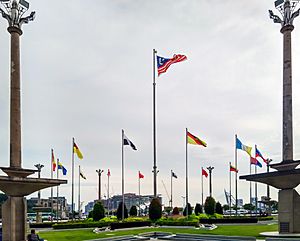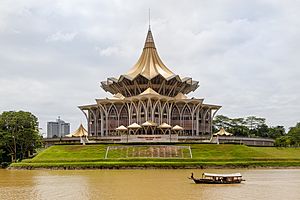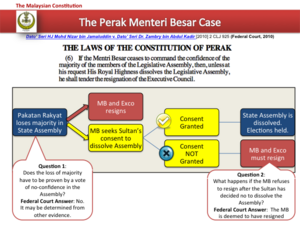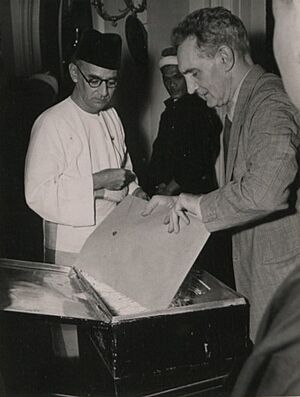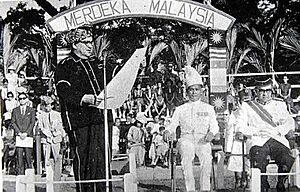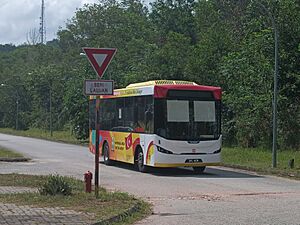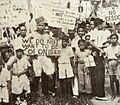States and federal territories of Malaysia facts for kids
Malaysia is a country made up of 13 states and 3 special areas called federal territories. These are the main parts that divide the country. Most of these states and territories are on a big piece of land called Peninsular Malaysia (also known as West Malaysia). The other two states and one territory are on the island of Borneo, known as East Malaysia.
Nine of the states on Peninsular Malaysia have a ruler (like a Sultan or King). The other four states have a governor chosen by the national King. Each state government is led by a chief minister. This person is chosen by the state's ruler or governor if they have the most support in the state's law-making assembly. The federal territories are managed directly by the national government.
Malaysia became a country by bringing together different areas that were once ruled by the United Kingdom. The idea of having a "federal system" (where power is shared) was created to keep the Malay rulers, called Sultans, in their important roles. In 1948, the Federation of Malaya was formed, bringing together these areas. Malaya became independent in 1957. Later, in 1963, Sabah, Sarawak, and Singapore joined Malaya to create Malaysia. Singapore left Malaysia in 1965. The three federal territories were created later from parts of existing states.
Contents
States and Federal Territories
Eleven states and two federal territories are on the Malay Peninsula, known as Peninsular Malaysia or West Malaysia. Two states and one federal territory are on the island of Borneo, called East Malaysia. Out of the 13 states, 9 are monarchies with their own rulers.
States
| Flag | Emblem | State | Capital | Royal capital | Pop. | Area (km2) |
Licence plate |
Area code | ISO | HDI | Head of state | Head of government |
|---|---|---|---|---|---|---|---|---|---|---|---|---|
| Johor | Johor Bahru | Muar | 4,186,300 | 19,210 | J | 07, 06 (Muar & Tangkak) |
MY-01 | 0.821 | Sultan | Menteri Besar | ||
| Kedah | Alor Setar | Anak Bukit | 2,217,500 | 9,500 | K | 04 | MY-02 | 0.804 | Sultan | Menteri Besar | ||
| Kelantan | Kota Bharu | Kubang Kerian | 1,888,500 | 15,099 | D | 09 | MY-03 | 0.774 | Sultan | Menteri Besar | ||
| Malacca | Malacca City | — | 1,047,100 | 1,664 | M | 06 | MY-04 | 0.831 | Governor | Chief Minister | ||
| Negeri Sembilan | Seremban | Seri Menanti | 1,240,100 | 6,686 | N | 06 | MY-05 | 0.825 | Yang di-Pertuan Besar | Menteri Besar | ||
| Pahang | Kuantan | Pekan | 1,668,200 | 36,137 | C | 09, 03 (Genting Highlands), 05 (Cameron Highlands) |
MY-06 | 0.801 | Sultan | Menteri Besar | ||
| Penang | George Town | — | 1,800,400 | 1,048 | P | 04 | MY-07 | 0.841 | Governor | Chief Minister | ||
| Perak | Ipoh | Kuala Kangsar | 2,569,600 | 21,035 | A | 05, 04 (Pengkalan Hulu) |
MY-08 | 0.812 | Sultan | Menteri Besar | ||
| Perlis | Kangar | Arau | 296,800 | 821 | R | 04 | MY-09 | 0.801 | King | Menteri Besar | ||
| Sabah | Kota Kinabalu | — | 3,742,200 | 73,631 | S | 08 | MY-12 | 0.772 | Governor | Chief Minister | ||
| Sarawak | Kuching | — | 2,518,100 | 124,450 | Q | 08 | MY-13 | 0.824 | Governor | Premier | ||
| Selangor | Shah Alam | Klang | 7,363,400 | 8,104 | B | 03 | MY-10 | 0.859 | Sultan | Menteri Besar | ||
| Terengganu | Kuala Terengganu | 1,232,100 | 13,035 | T | 09 | MY-11 | 0.796 | Sultan | Menteri Besar | |||
Federal Territories
| Flag | Emblem | Federal Territory | Pop. | Area (km2) | License plate | Area code | ISO | HDI | Head of government |
|---|---|---|---|---|---|---|---|---|---|
| Kuala Lumpur | 2,067,500 | 243 | W / V | 03 | MY-14 | 0.863 | Mayor | ||
| Labuan | 100,800 | 91 | L | 087 | MY-15 | 0.782 | CEO of Labuan Corporation | ||
| Putrajaya | 120,300 | 49 | F | 038 | MY-16 | N/A | President of Putrajaya Corporation |
How the Government Works
Malaysia has many different groups of people and religions. The way the country is set up, with states and a central government, helped keep the special roles of the Malay rulers (Sultans). Even though Malaysia is a "federation" (meaning power is shared), the central government actually holds most of the power. This is because the country's main law gives a lot of power to the central government.
States have some power, but it's mostly about managing Islamic laws and how their own rulers work. The central government can even change state laws if they clash with national laws. The Federal Court of Malaysia helps solve any disagreements between states or between states and the central government.
The King and the Conference of Rulers (made up of all the state rulers) have a say in big decisions, like changes to royal matters or state borders. But mostly, their roles are symbolic. Each state also sends two people to represent them in the national Senate, which is part of the federal parliament.
The federal parliament can make laws for states, and sometimes the central government can even take control of a state's administration during special times, like an emergency. Laws like the Security Offences (Special Measures) Act 2012 give the national government broad powers for security reasons.
Over the years, the central government has gained more and more power. This happened partly because one political group, Barisan Nasional, ruled for a very long time. They could control states through their political party. The Prime Minister's Department also has a lot of control over important areas like elections and big companies. The Prime Minister often also controls the country's money as the Minister of Finance.
Sharing of Powers
The Malaysian Constitution lists what powers belong to the federal government, what belongs to the states, and what they share.
- Federal powers include things like trade, foreign affairs, national laws, security, police, and education.
- State powers include Islamic law, local government, and how land and natural resources are used.
- Shared powers (where both have a say) include welfare, water, planning, culture, sports, and health.
Each state has its own Syariah Court system for Islamic law. These courts are separate from the main federal courts. In Sabah and Sarawak, there are also special courts for the traditional laws of their local people.
If something isn't listed in the Constitution, states can technically make laws about it. But because the federal list is so big, there aren't many topics left for states alone. The national parliament can also make laws about land, religion, and local government if states ask them to, or to make laws uniform across states.
Money Matters
States in Malaysia have very limited ways to earn money. Most taxes and customs duties are collected by the federal government. States mainly get money from natural resources (like land) and some entertainment or religious activities. This means states often depend a lot on money given to them by the federal government.
In 2016, all states together collected only about a tenth of the money the federal government collected. This makes it hard for states to provide many services on their own. The federal government gives grants to states, but these grants are usually for specific projects approved by the federal government. States also need federal approval to borrow money. This gives the national government a lot of control over big projects in the states.
States often have to take loans from the central government because they don't have enough funds. There's a National Finance Council that discusses money matters, but the federal government has more power in its decisions.
Other Ways the Federal Government Influences States
The central government appoints many important officials in state governments, especially in states that were not original sultanates. This means the federal government can influence what state civil servants do. The federal government can also directly fund local projects, sometimes bypassing the state government entirely.
Over time, the federal government has created many national bodies and laws that make state laws more uniform, especially in Peninsular Malaysia. For example, the National Land Code and the Local Government Act 1976 help make rules about land and local government similar across states. These national bodies help the federal government guide state policies.
The federal government also took control of oil and natural gas resources from states like Sabah, Sarawak, and Terengganu. It also controls some special "development authorities" in certain areas, even if they are within a state.
Special Status for Sabah and Sarawak
The states of Sabah and Sarawak in East Malaysia have more independence than the states on the peninsula. This was agreed upon when they joined Malaysia because they are geographically separate and have different cultures and economies.
They have more control over their land, development, and even immigration. Some federal laws that apply to other states don't apply to Sabah and Sarawak. They can also collect more of their own taxes and have their own legal systems. Their governors can even stop changes to the Constitution that affect their states or the rights of their local people. This special arrangement makes Malaysia's federal system "asymmetric," meaning it's not the same for all states.
Sabah and Sarawak manage their own immigration. This means people from Peninsular Malaysia usually need a passport or a special document to enter these states, and their stay might be limited.
Sometimes, there are disagreements between Sabah, Sarawak, and the central government. The states worry about the central government having too much power, and there have been talks about them wanting more control over their own affairs.
How States are Governed
The states are governed by both the federal government and their own state governments. The federal territories, however, are managed directly by the federal government.
Nine states on the peninsula have a monarch (like a Sultan or King) as their head. These rulers are important symbols of Malay culture and Islam. The national King, called the Yang di-Pertuan Agong, is chosen from these nine rulers every five years. The other four states (Malacca, Penang, Sabah, and Sarawak) have governors who are appointed by the national King.
Each state has its own set of laws, called a constitution, which must follow the national constitution. They also have a law-making body, like a mini-parliament, called the Dewan Undangan Negeri (DUN). People vote for members of the DUN every five years. Each state also sends two people to represent them in the national Senate. Besides the national court system, each state has its own Syariah Court for Islamic law.
The head of the state government is called the chief minister. In some states, they are called menteri besar or "premier." The chief minister is chosen by the state's ruler or governor, based on who has the most support in the state's law-making body. The chief minister leads a team of people who help run the state.
States are divided into smaller areas called districts, and then into sub-districts. The smallest unit is the village, led by a village chief. Sabah and Sarawak have slightly different ways of dividing their areas and managing local government.
How Federal Territories are Governed
Malaysia has three federal territories: Kuala Lumpur, Putrajaya, and Labuan.
- Kuala Lumpur became a federal territory to be the country's independent capital city.
- Putrajaya was created as the main administrative center for the federal government.
- Labuan was made a special financial center.
These territories are managed directly by the Ministry of Federal Territories. The national Parliament makes all the laws for them. People in these territories vote for representatives to the national Parliament. The national King also appoints senators to represent them in the Senate.
Unlike states, federal territories do not have their own elections for local leaders. The federal government handles many things that states would normally manage. They also share one Syariah Court system for all three territories. Each territory has its own local government body, like the Kuala Lumpur City Hall led by a mayor.
A Brief History of Malaysia's States
How Malaysia Was Formed
Malaysia's system of states and a central government came from how the British ruled the Malay Peninsula. The British first directly controlled areas like Penang, Singapore, and Malacca. Later, they made agreements with the Malay rulers, creating "protectorates" where the Sultans still had power but were guided by British advisors. This helped strengthen the Sultans' positions.
In 1895, some of these states (Negeri Sembilan, Pahang, Perak, and Selangor) joined to form the Federated Malay States. This group had a shared government, but the Sultans still kept some power. Other states remained separate.
After World War II, in 1946, the British tried to unite the states into the Malayan Union. This union would have given the central government a lot of power and reduced the Sultans' roles. Many people, especially Malays, did not like this plan because they felt it threatened their identity and the Sultans' authority.
Because of strong opposition, the Malayan Union was replaced in 1948 by the Federation of Malaya. This new federation gave more power back to the Sultans and the states. It also included ways for the states and the central government to talk things over. Malaya became fully independent in 1957.
Joining of Sabah, Sarawak, and Singapore
On the island of Borneo, North Borneo (now Sabah) and Sarawak were also British colonies. They had different histories and cultures from Malaya. British leaders thought these areas would be stronger if they joined a larger country. Singapore, which was also a British colony, wanted to join Malaya for economic and security reasons.
In 1963, Malaya, along with Sabah, Sarawak, and Singapore, came together to form Malaysia. This was a big step! Sabah and Sarawak were given special agreements, like the Malaysia Agreement, to ensure they kept more control over their own affairs, such as immigration and land. This was because they were so different from the states on the peninsula.
However, Singapore left Malaysia in 1965. This meant Malaysia became the country we know today, with 13 states and 3 federal territories.
The Rise of Central Power
For many years, one political group called Barisan Nasional (BN) led the national government. During this time, the central government gained more and more power. They made new laws and created national agencies that gave them more control over areas that states used to manage. For example, the central government took over control of oil and gas production from states like Sabah, Sarawak, and Terengganu.
The federal government also created the federal territories. Kuala Lumpur became a federal territory in 1974 to be the national capital. Labuan became a federal territory in 1984, and Putrajaya in 2001, to serve specific national purposes.
When states were led by opposition parties (not BN), the central government sometimes reduced funding or made it harder for them to develop. This showed how much influence the central government had.
Recent Changes and Discussions
In 2018, for the first time, the BN coalition lost power in the national election. A new group, Pakatan Harapan (PH), took over. They promised to bring back the "true spirit of federalism" and give more power to Sabah and Sarawak.
Since then, there have been many discussions about how to better share power between the federal government and the states, especially with Sabah and Sarawak. There have been efforts to give these two states more control over their resources and a bigger say in national decisions.
The political landscape has become more varied, with different parties leading states. This has led to more talks and efforts to balance power. For example, Sarawak has pushed for more control over its oil resources and even its education system. States like Johor have also called for more equal treatment from the federal government.
The goal is to make sure that while Malaysia remains united, each state has enough power and resources to manage its own affairs and develop for its people.
Brunei and Singapore's Connection to Malaysia
Brunei's Decision
The United Kingdom wanted Brunei to join Malaysia, along with Sabah and Sarawak. However, Brunei's ruler, the Sultan, was not keen on giving up control or sharing Brunei's oil money. Even though there were talks and a palace was even built for the Sultan in Kuala Lumpur, Brunei decided not to join Malaysia in 1963. This was mainly due to disagreements over oil revenues and its position within the new federation.
Singapore's Time in Malaysia
Singapore was a state of Malaysia from 1963 to 1965. During this short period, Singapore had some control over its own education and labor matters. However, it had fewer representatives in the national parliament compared to its population size. Singapore was later separated from Malaysia in 1965 and became an independent country.
Images for kids
See also
- List of current heads of states and governments of Malaysia
- List of Malaysian states by GDP
- List of Malaysian states by exports
- List of Malaysian states by household income
- List of Malaysian states by salary
- State emblems of Malaysia














